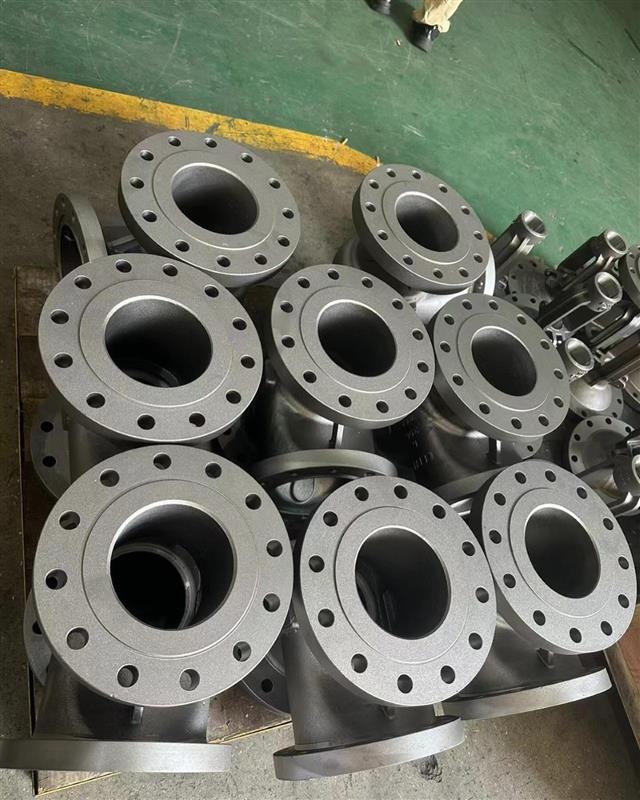- Control Valve
- Pneumatic Control Valve
- Pneumatic Angle Control Valve
- 3 Way pneumatic Diaphragm Control Valve
- 3 Way Converging and Diverging Control Valve
- Fluorine Lined Single Seat Control Valve
- Pneumatic Cage Control Valve
- Pneumatic Double Seat Control Valve
- Pneumatic Single Seat Globe Control Valve
- Pneumatic Flow Control Valve
- Pneumatic Sleeve Type Control Valve
- Pneumatic Actuated Globe Type Control Valve
- Electric Actuated Control Valve
- Pneumatic Control Valve
- Cryogenic Valve
- Pressure Reducing Valve
- Safety Valve
- Check Valve
- Gate Valve
- Butterfly Valve
- Globe Valve
- Ball Valve
- Electric Actuated Valve
- Electric Actuated Ball Valve
- Electric Actuated Butterfly Valve
- Electric Actuated Gate Valve
- Electric Actuated Globe Valve
- Pneumatic Actuated Valve
- Plunger Valve
- Strainers
- Steam Trap
- Knife Gate Valve
- Speciality Valve
- Alloy 20 Valve
- Duplex Valve
- Super Duplex Valve
- Hastelloy C276/B3 Valve
- Aluminium Bronze Valve
- Titanium Valve
- Bronze Valve
- Monel Valve
- Triple Duty Valve
- Suction Diffuser
- Diaphragm Valve
- Plug Valve
- Foot Valve
- Air Release Valve
- Surge Anticipator Valve
- Needle Valve
- Balancing Valve
SLIP-ON VS WELD NECK FLANGE: WHICH ONE TO CHOOSE

Middleeast Valve is a leading manufacturer and distributor of industrial pipe fitting and valve products in the Middle East region, from Saudi Arabia to UAE, Kuwait, Oman, Riyadh etc. It seeks to provide effective, dependable, and application for adjusted flow control products as well as solutions to numerous industries including oil & gas, petrochemicals, power generation, and water treatment.
Among the most frequent queries of procurement teams and engineers is: Slip-On vs Weld Neck Flange Which one To Use- Both these commonly encountered classes of flanges have the vital function of connecting pipes, valves, pumps, and other equipment in piping systems. However, their design, installation process, cost, and performance are vastly different. Awareness of their differences is the answer to choosing the right flange for your application.
Definition: Slip-On and Weld Neck Flange
A slip on flange is a flange that is slipped over the pipe and fillet welded inside and outside to add strength and seal against leakage. It is popular for its ease of alignment and installation and hence it is a first choice for low pressure and non critical application.
Weld neck flange are designed with a long, tapered hub that is butt welded to the pipe. This makes for a smooth transition from pipe to flange, minimizing stress concentrations and providing superior strength. Weld neck flanges are best suited for high pressure, high temperature and critical services.
Major Components
Slip On Flange:
- Flange Face: Raised face (RF), flat face (FF), or ring type joint (RTJ)
- Bore: Slightly bigger than the pipe OD to facilitate easy sliding
- Weld Area: Two welds—inside and outside are required
- Bolt Holes: Uniformly spaced for safe bolting
Weld Neck Flange:
- Tapered Hub: Provides for tapering change in thickness between pipe and flange
- Flange Face: Generally raised face or RTJ for high sealing capacity
- Weld Neck: Provided with butt welding to the pipe
- Bolt Holes: For secure bolting with gasket sealing
Working Mechanism
Slip-On Flange
The decision between slip-on and weld neck flanges may significantly affect the reliability and operation of your piping system. A misjudged decision can result in frequent leakage, pipe misalignment, structure collapse, or additional maintenance cost.
Weld Neck Flange
Weld neck flanges are welded to the pipe by a full penetration butt weld. The configuration shares mechanical stress evenly along the tapered hub and into the pipe, minimizing stress concentrations. This is best suited for application in harsh service conditions of high pressure, temperature, or toxic fluids.
Advantages
Slip-On Flange:
- Less difficult to install and align
- Less expensive and easily accessible
- Less welding and accurate pipe cutting required
- Best suited for low-pressure, non-critical applications
- Preferred in applications that require frequent disassembly
Weld Neck Flange:
- Highest structural strength and integrity
- Suitable for highest pressure and temperature conditions
- Eliminates possibility of leakages and fatigue failures
- Long maintenance-free service life
- Provides smooth flow transition and minimizes turbulence
Industries Served
Slip-On Flange:
- Water treatment and wastewater plants
- Fire protection systems
- Heating, ventilation, and air conditioning piping systems
- Low-pressure chemical and food processing industries
- General pipeline assembly
Weld Neck Flange:
- Oil and gas (land and offshore)
- Petroleum refinery plants
- Nuclear and thermal power plants
- Shipbuilding and marine piping
- High-pressure steam and cryogenic systems
Why Is It Required?
The decision between slip-on and weld neck flanges may significantly affect the reliability and operation of your piping system. A misjudged decision can result in frequent leakage, pipe misalignment, structure collapse, or additional maintenance cost.
For instance, when you fit a slip-on flange into a high-pressure setting, the welds may not be strong enough in the long term and may leak or fail. On the other hand, applying a weld neck flange in a low-pressure, non-critical line would be excessive and more costly than required. Hence, knowledge of Slip-On vs Weld Neck Flange: Which One to Choose is vital to cost-effective and safe system design.
Why Customers Should Buy from Middleeast Valve
We not only sell flanges at Middleeast Valve; we provide complete piping solutions. We have a wide range of flanges available in different sizes, pressure classes, and materials (carbon steel, stainless steel, alloy steel). We follow very high quality standards (ASME, ANSI, API, ISO) to make them as stable and long-lasting as possible.
Why Middleeast Valve:
- Large stock of slip-on and weld neck flanges
- Competitive rates and prompt shipping
- Products certified to international specifications
- Tailor-made solutions for high-spec projects
- In-house technical assistance for design and choice
- Superb after-sales support
Conclusion
All in all, when considering Slip-On vs Weld Neck Flange: Which One to Use, your choice should be determined by your particular system requirements. For low-pressure, cost-sensitive installations where alignment is of utmost importance, slip-on flanges are the best choice. For demanding systems that require high performance, strength, and reliability, weld neck flanges are the best option.
Let Middleeast Valve be your trusted partner in selecting the right option. With our years of experience, technical knowledge, and focus on quality, we are your one-source solution provider for Middle East industrial flanges and valve solutions. Reach out to us today for expert guidance and reliable products engineered to meet the most demanding conditions.

